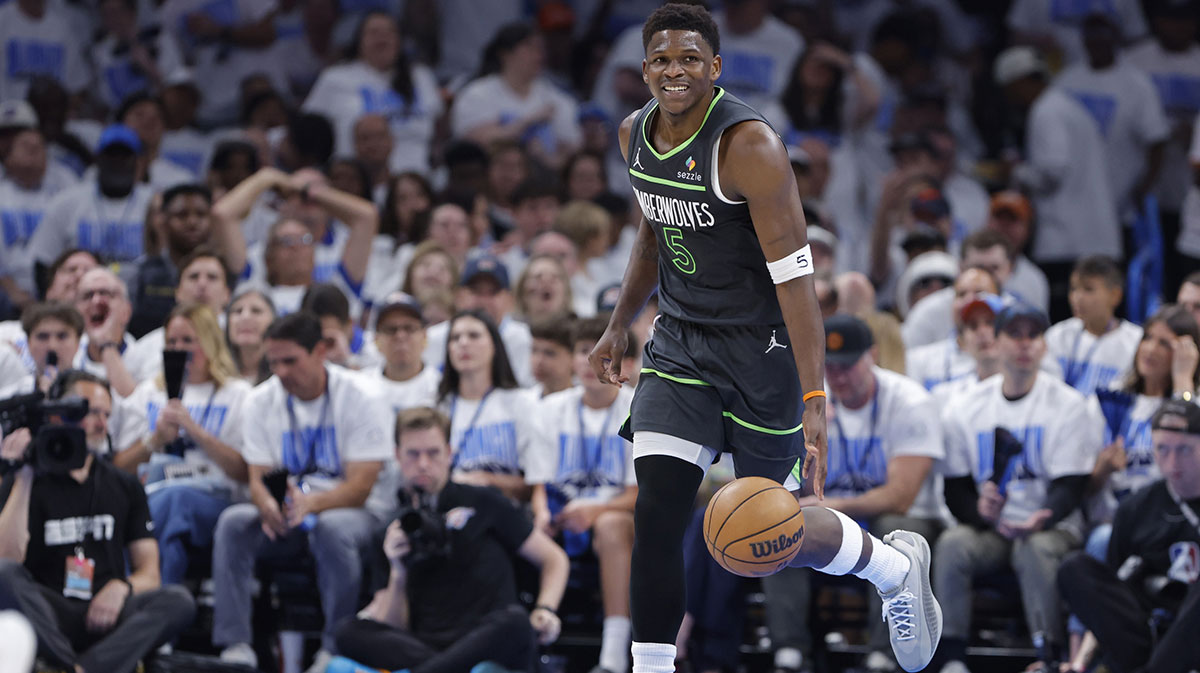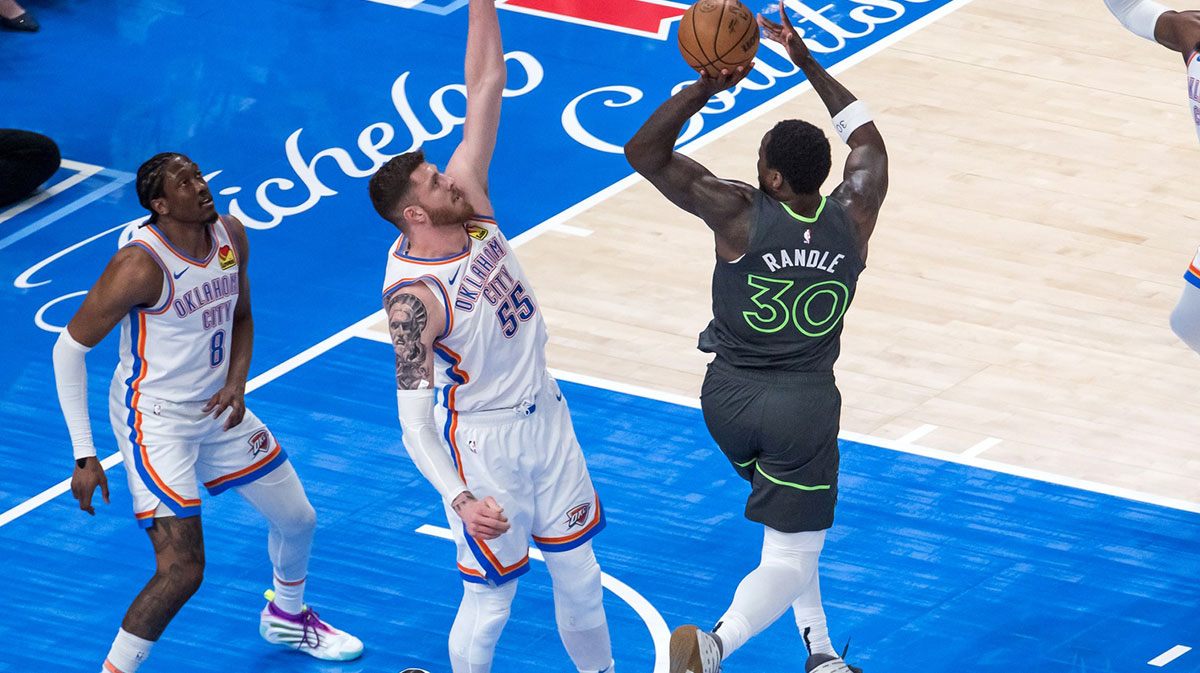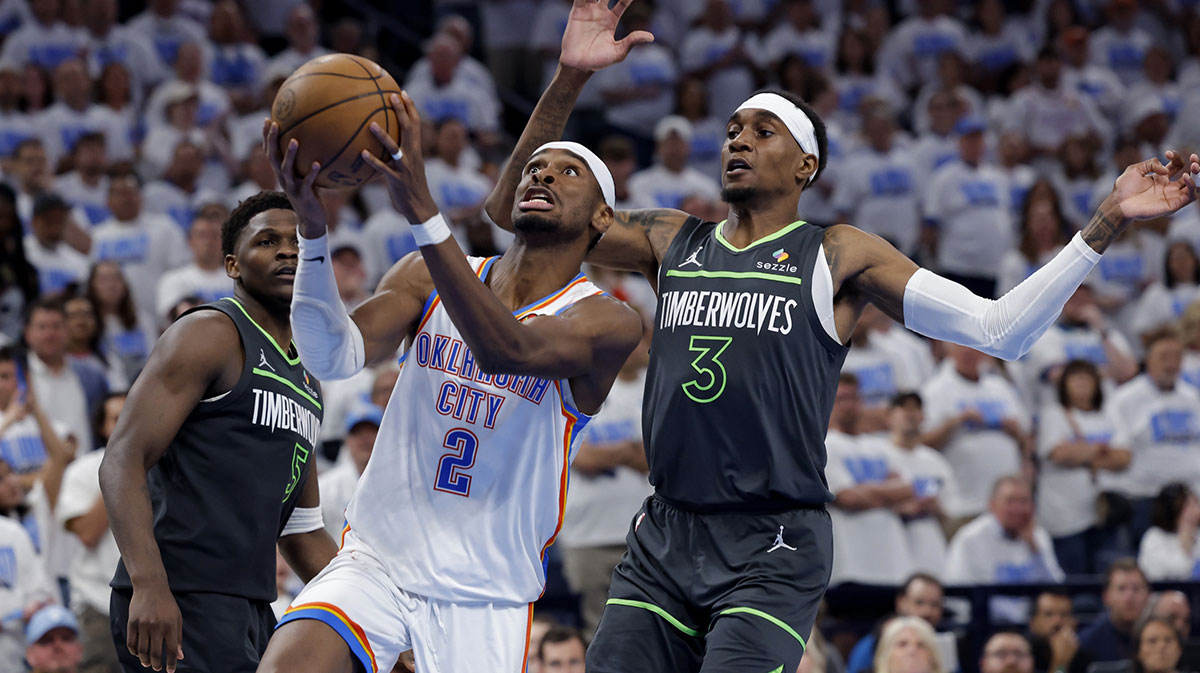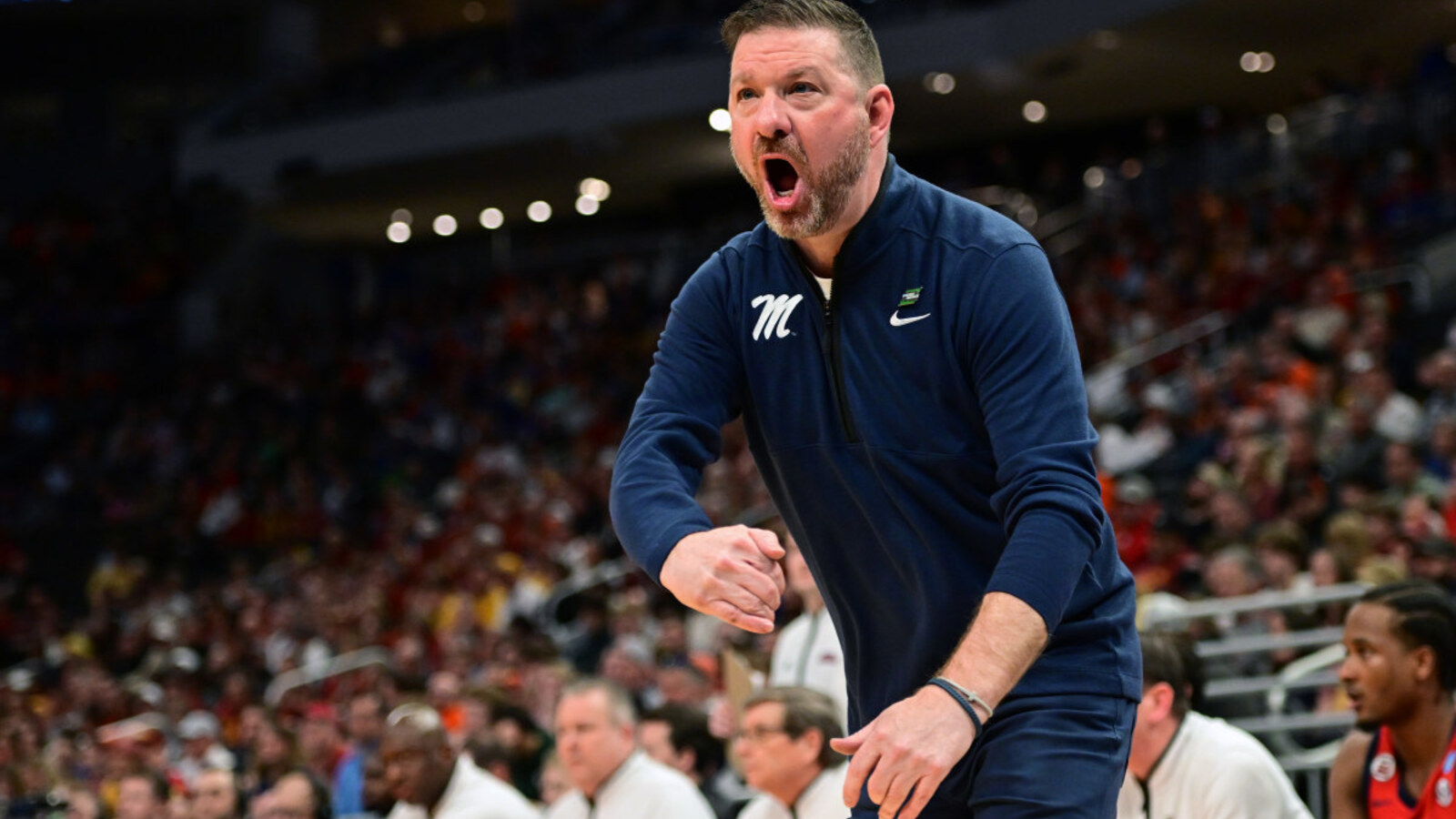The Minnesota Timberwolves could not have asked for a better start to the first quarter of Game 1 in the Western Conference Finals against the Oklahoma City Thunder. After Jaden McDaniels scored five quick points on back-to-back possessions, Anthony Edwards showed off his handles with a step-back three over Chet Holmgren. All of a sudden, the Wolves found themselves on an 8-0 run, and the Thunder couldn't find their offense.
Shai Gilgeous-Alexander quickly settled things down by driving down the lane and either scoring or getting to the free-throw line, but Julius Randle and Edwards were finding success from beyond the 3-point line. That trend continued in the second quarter, as Randle knocked down three total perimeter shots without Edwards on the floor.
At the end of the first quarter, the Timberwolves superstar rolled his right ankle and briefly went to the locker room. Edwards has been dealing with an injured ankle for weeks, which is why the team exercised extra caution in Game 1 with their best player in obvious discomfort.
Even so, Minnesota looked to be in control of this game. After leading 23-20 at the end of the first quarter, Randle's offensive success and 20-point half extended the Timberwolves' lead, as they were up 48-44 heading into halftime. While Gilgeous-Alexander was the driving force behind the Thunder keeping things close, this young team was receiving bits of production from others.
That ultimately factored into Oklahoma City's second-half comeback.
With the Timberwolves offense failing and the Thunder taking a 10-point lead into the fourth quarter, Oklahoma City took over in every aspect of the game. The Timberwolves had no answers, and ultimately went on to fall 114-88, losing Game 1 on the road.
Chris Finch and his team now have their work cut out for them. Obvious adjustments need to be made heading into Game 2, but the fact is that the Thunder handled their business. This is the 1-seed in the West for a reason, and they have set the tone of the series.
However, the Timberwolves did not play well other than the opening quarter. Edwards looked flat, this team wasn't aggressive in terms of hunting high-percentage shots, and the open looks they got did not fall.
When you shoot 34.9 percent from the floor and 29.4 percent from 3-point range, you aren't going to win many games. That is especially true in the playoffs against a 68-win Thunder team with Gilgeous-Alexander, who will be named the 2024-25 NBA MVP on Wednesday night.
Minor tweaks and fixes could go a long way in this series, yet there are glaring weaknesses and concerns that stood out for Minnesota in their Game 1 loss.
Here are the three biggest problems Finch, Edwards, and the Timberwolves need to address to possibly win Game 2 and this series against the Thunder.

Edwards didn't look like himself in Game 1 against the Thunder. Perhaps his ankle injury was bothering him after that slight tweak at the end of the first quarter, but the bottom line is he must play like a superstar in this series for the Timberwolves to have a shot at advancing to their first NBA Finals in team history.
Obviously, the Timberwolves would like to see him as the game's leading scorer and punish the Thunder with his speed and athleticism. At the same time, this isn't the only way Edwards can stand out as a superstar.
Oklahoma City shot the ball well and they were very aggressive on defense. Those are two of the three reasons they won Game 1. The third reason is Gilgeous-Alexander found ways to get others involved while still hunting his own shots.
Gilgeous-Alexander finished Tuesday night's game with a game-high nine assists, all of which led to big shots that allowed the Thunder to build their second-half lead. Although Edwards can only control so much in terms of being a playmaker and those around him knocking down the shots, he can't play too overly aggressively to the point where Minnesota starts turning the ball over.
Edward alone had four turnovers in this game, and Randle had five turnovers — some of which came by way of Edwards deferring to him on offense.
The Timberwolves are at their best when Edwards is attacking the paint and getting those around him involved. Moving the ball and finding open shooters will be essential for Minnesota in this series. Ultimately, nobody was making shots in Game 1, so it didn't matter much who was open.
Looking ahead to Game 2 on Thursday, Edwards will be tasked with finding his teammates for easy looks when the Thunder apply pressure to him, and his teammates must step up to hit big-time shots. Naz Reid, Donte DiVincenzo, and Nickeil Alexander-Walker combining for 21 points off the bench on 7-of-36 shooting isn't going to cut it.
This is Edwards' moment.
After falling short of his goals in the Western Conference Finals last season, he has a second chance to correct his wrongs and be the leader the Timberwolves need him to be. Expect a much more aggressive mindset from Edwards in Game 2 and the young star looking to pass right away when doubled by Oklahoma City.

Related Minnesota Timberwolves NewsArticle continues below
Of the 83 shots that the Timberwolves attempted in Game 1, 51 shots came from the perimeter. Minnesota knocked down 15 shots from beyond the 3-point line, but they shot just 29.4 percent from distance.
In the third quarter alone, the Timberwolves only attempted six shots from inside the 3-point line. By the time that offensive mindset changed in the fourth quarter, it was too late.
Even though this team has been one of the best perimeter shooting teams in the league this season, Edwards and Co. aren't going to win four games against the Thunder by getting up as many 3-point shots as possible.
That was displayed in Game 1, as Oklahoma City's defense is too good for Minnesota's offense to become stagnant.
After losing Game 1, the fouls being called was a hot topic of discussion regarding the Timberwolves. While Gilgeous-Alexander and the Thunder were getting certain calls, those same decisions by the officials were not being reciprocated on the opposite end of the floor in the same manner from Minnesota's point of view.
The main reason for this was that Gilgeous-Alexander and the Thunder were the more aggressive team. Unlike the Wolves, who were content playing on the perimeter and not looking to draw contact on the interior, Oklahoma City constantly applied pressure on the interior against Edwards, Reid, and Jaden McDaniels, who ultimately fouled out of this game.
One thing that stood out from the Thunder's Game 1 win was Mark Daigneault's decision to go small at times with Alex Caruso and Kenrich Williams in his frontcourt. While both players are respected veteran defenders, they aren't the same factors as Chet Holmgren and Isaiah Hartenstein when it comes to protecting the rim.
Should Daigneault go to the same rotations in Game 2, the Timberwolves must have a plan to attack and punish the Thunder for going small. Between Edwards, Randle, McDaniels, DiVincenzo, and Conley, the Wolves have the talent to drive the ball and get their momentum going to the rim.
More than likely, Caruso and others will get their hands caught in the cookie jar and end up fouling Minnesota, whose athleticism would triumph in these matchups. That small difference and getting a few more opportunities around the rim can not only get the Thunder in foul trouble but slow the pace of play and momentum down.

During the regular season, the Thunder ranked first in the league in points of their opponent's turnovers. Oklahoma City averaged 21.8 points per game off turnovers. In the playoffs, this success has continued, as the Thunder are averaging 25.3 points off turnovers, and they are punishing their opponents by pushing the pace when this happens.
This proved to be the case in Game 1 on Tuesday night, as Gilgeous-Alexander, Jalen Williams, and others consistently converted fastbreak opportunities off Minnesota's turnovers. The Timberwolves had 19 turnovers leading to 31 points for the Thunder.
Not much else really needs to be said about this game when you look at this one statistic.
Taking care of the basketball is going to be essential in this series for the Timberwolves. That was a weakness the Golden State Warriors looked to expose, and found success doing, in the Western Conference Semifinals. The Thunder have proven to be a better defensive team all year than the Warriors, which is why those mistakes from Edwards and others hurt even more in the Western Conference Finals.
As cliché as it may sound, the Timberwolves simply can't be careless with the basketball against the Thunder. As soon as Oklahoma City increased the tempo of play and converted on a few opportunities in transition off of turnovers, Finch's course of attack began to spiral out of control and his team lost their composure.
Cutting down on their careless mistakes will allow the Timberwolves to control the pace of play.










